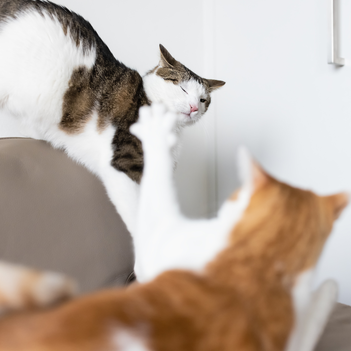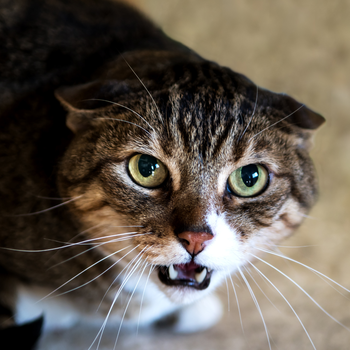Solutions to Prevent Surrendering Your Cat
Surrendering cats to shelters and rescue organizations by their owners is a nationwide problem. A study of 2,255 rescue organizations and animal shelters reported that 660,807 cats were relinquished by their owners in 2016 alone. The issues owners give for surrendering their cats usually fall into similar categories, and in many cases these issues are correctable with time, patience, and the right training. In fact, the majority of behavioral issue can actually be resolved or greatly reduced just by spaying/neutering you cat. For the sake of your cat, and others without homes, it is important to take every step possible to avoid surrendering your cat.
Click on the links below for solutions to your cat's problematic behavior.
Click on the links below for solutions to your cat's problematic behavior.
|
Behavior Issues in Elderly Cats
As cats age, they often suffer from a decrease in the ability to function. Cognitive decline, known as feline cognitive dysfunction (FCD), affects over half of cats aged 11 to 15 years old, and more than 80% of cats aged 16 to 20 years old. FCD affects elderly cats’ memory, ability to learn, awareness, sight, and hearing, all of which can effect your cat’s behavior. Some problems that may arise as a result of FCD are:
|
NOTE REGARDING SENIOR CATS
Senior cats will have an especially difficult time adjusting to new environments and people. If you cannot find a way to keep your senior cat, please try to rehome her without taking her to a shelter. |
- Relationships and Social Behavior
- Decreased interest in petting, interactions, greeting people or familiar pets, etc.
- Becomes overly dependent or clingy
- Activity; Decreased and Apathetic
- Explores less and is less interested in things going on around her
- Grooms herself less
- Eats less
- Anxiety and Increased Irritability
- Appears restless or agitated
- Vocalizes more and/or in a more urgent tone
- Generally behaviors more irritably
- Sleep-Wake Cycles and Reversed Day-Night Schedule
- Restless sleep, wakes up during the night
- Sleeps more during the day
- Vocalizes more at night
Other Causes for Your Cat's Behavior
If you observe your cat exhibiting any of the above behaviors, take her to the vet to determine if there is an underlying medical cause. Many other illnesses that can affect elderly cats, such as arthritis, dental disease, cancer, impaired sight or hearing, or urinary tract infections, can lead to increased sensitivity and irritability, increased anxiety or aggression, decreased responsiveness for your voice, reduced ability to adapt to change, and reduced ability to get to regular elimination areas.
If medical problems are ruled out by your vet, your cat’s behavior may be a result of the effects of aging on the brain.
Treating Cognitive Dysfunction
If your vet has determined that cognitive dysfunction is the cause of the changes in your cat’s behavior, the next step is to start therapy. Treatment largely consists of making helpful changes to your cat’s environment and providing her with a consistent schedule. Currently there are no FCD medications that are licensed for use in cats, but your vet may consider an anti-anxiety medication.
Eliminating Outside the Litter Box
Litter box issues are the most common reason that older cats are seen by behaviorists. Once your vet has ruled out underlying medical conditions, try these suggestions:
Confusion and Disorientation
Disorientation is commonly found in elderly cats with cognitive decline. Disorientation may be reduced by increasing the stability of your cat’s environment and schedule. Avoid changes to her food, food dish locations, litter box and litter box locations. If you feel she is really distressed, it may be best to keep her in a relatively small space, such as one floor of your house. This way it will be easier to find the things she needs.
Restlessness and Waking at Night
FCD can impair your cat’s sleep-wake cycle, but there are also other alternative reasons for an increase in nighttime activity. Eyesight or hearing loss can affect your cat’s depth of sleep. An increased need to eliminate at night and the inability to locate the litter box can lead to your cat waking up and wandering around. Have your vet do a thorough examination to pinpoint what is causing these issues. At home, try to reestablish your cat’s normal sleep/wake cycle. Increase her activity level by playing with her during the day and in the evening so she’ll be tired at night.
Anxiety can also be the cause of increased activity at night. Nighttime anxiety is a common feature of geriatric anxiety, and can be treated with pheromones or medication.
Excessive Vocalization
Disorientation, loss of hearing, and pain due to one or more medical conditions may be the reason why your cat is vocalizing excessively. As with other symptoms of FCD, an examination by your vet is the first step to rule out or address any medical problems contributing to her condition.
Increased vocalization due to FCD is usually associated with anxiety, disorientation, and separation distress. This become problematic when your elderly cat vocalizes excessively or while you are sleeping. Punishing your cat will only increase her anxiety and make the problem worse. Instead, increase your cat’s activity during the day and work towards reestablishing her normal sleep/wake cycle.
Other Causes for Your Cat's Behavior
If you observe your cat exhibiting any of the above behaviors, take her to the vet to determine if there is an underlying medical cause. Many other illnesses that can affect elderly cats, such as arthritis, dental disease, cancer, impaired sight or hearing, or urinary tract infections, can lead to increased sensitivity and irritability, increased anxiety or aggression, decreased responsiveness for your voice, reduced ability to adapt to change, and reduced ability to get to regular elimination areas.
If medical problems are ruled out by your vet, your cat’s behavior may be a result of the effects of aging on the brain.
Treating Cognitive Dysfunction
If your vet has determined that cognitive dysfunction is the cause of the changes in your cat’s behavior, the next step is to start therapy. Treatment largely consists of making helpful changes to your cat’s environment and providing her with a consistent schedule. Currently there are no FCD medications that are licensed for use in cats, but your vet may consider an anti-anxiety medication.
Eliminating Outside the Litter Box
Litter box issues are the most common reason that older cats are seen by behaviorists. Once your vet has ruled out underlying medical conditions, try these suggestions:
- Increase the number of litter boxes in your house. If you live in a multilevel house, place one litter box on each floor in case your cat is struggling to go up or down stairs.
- Place additional litter boxes in easy to find and easy to access locations. Keep the existing boxes in the same location, but place new boxes in obvious areas around the house.
- Use litter boxes with low sides. Older cats may have trouble attempting to get in or out of a box with high sides.
Confusion and Disorientation
Disorientation is commonly found in elderly cats with cognitive decline. Disorientation may be reduced by increasing the stability of your cat’s environment and schedule. Avoid changes to her food, food dish locations, litter box and litter box locations. If you feel she is really distressed, it may be best to keep her in a relatively small space, such as one floor of your house. This way it will be easier to find the things she needs.
Restlessness and Waking at Night
FCD can impair your cat’s sleep-wake cycle, but there are also other alternative reasons for an increase in nighttime activity. Eyesight or hearing loss can affect your cat’s depth of sleep. An increased need to eliminate at night and the inability to locate the litter box can lead to your cat waking up and wandering around. Have your vet do a thorough examination to pinpoint what is causing these issues. At home, try to reestablish your cat’s normal sleep/wake cycle. Increase her activity level by playing with her during the day and in the evening so she’ll be tired at night.
Anxiety can also be the cause of increased activity at night. Nighttime anxiety is a common feature of geriatric anxiety, and can be treated with pheromones or medication.
Excessive Vocalization
Disorientation, loss of hearing, and pain due to one or more medical conditions may be the reason why your cat is vocalizing excessively. As with other symptoms of FCD, an examination by your vet is the first step to rule out or address any medical problems contributing to her condition.
Increased vocalization due to FCD is usually associated with anxiety, disorientation, and separation distress. This become problematic when your elderly cat vocalizes excessively or while you are sleeping. Punishing your cat will only increase her anxiety and make the problem worse. Instead, increase your cat’s activity during the day and work towards reestablishing her normal sleep/wake cycle.
If you are still have trouble correcting the issues with your cat, consult you vet and discuss the problems you and your cat are experiencing. They can recommend solutions of their own, as well as refer you to an animal behaviorist, who is trained in dealing with and solving the issues that you and you cat are facing.
As a last resort, rehome your cat - network her on social media and post her on Adopt-a-Pet's Rehome site.
Best Friends and The Rescue Train also offer great tips for find your cat a new permanent home.
As a last resort, rehome your cat - network her on social media and post her on Adopt-a-Pet's Rehome site.
Best Friends and The Rescue Train also offer great tips for find your cat a new permanent home.





